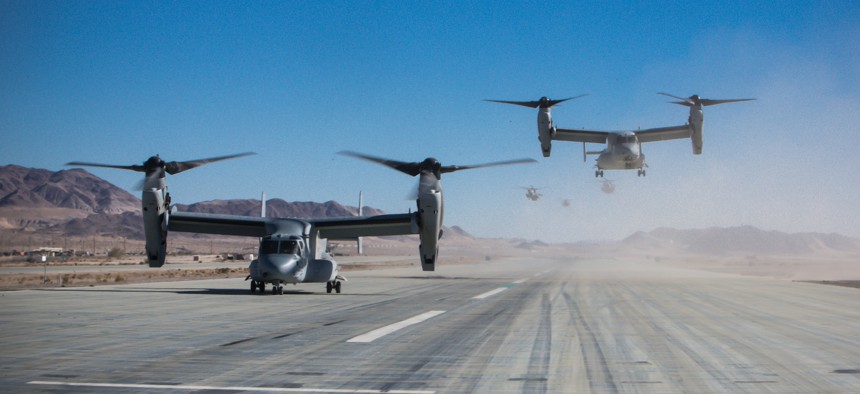
In this 2017 photo, MV-22B Ospreys with Marine Medium Tiltrotor Squadron 364 return from a flight mission in support of an exercise. U.S. Marine Corps / Lance Cpl. Nadia J. Stark
Gearbox problem caused fatal Osprey crash, Marines say
The incident was the 16th hard clutch engagement since 2010, but the first that resulted in deaths.
The MV-22B Osprey crash that killed five Marines in California last June was caused by a gear problem the service has known about for years, according to a 436-page redacted command investigation released Friday.
A “dual hard clutch engagement” caused an engine and the interconnect drive system to fail, which led to the “catastrophic loss of thrust” on the right proprotor, the Marine Corps said in a statement. “The degraded drivetrain caused by the dual HCE event and subsequent single engine/ICDS failure created an unrecoverable departure from controlled flight, resulting in the tragic crash that occurred on June 8, 2022.”
The pilots, crew, and maintenance of the aircraft were not to blame in the crash, the V-22 Joint Program Office said in their statement.
“It was determined the pilots and aircrew were conducting routine flight operations in accordance with applicable regulations when a catastrophic, unpreventable and unanticipated mechanical failure occurred,” the office said.
The Marine Corps has known about the hard clutch engagement problem in the V-22 aircraft since 2010, and changed its protocols to mitigate it when it happens. Air Force Special Operations Command in 2022 grounded its fleet of the tiltrotor aircraft for a few weeks because of what it called “an increased number of safety incidents,” all involving hard clutch engagements. The Marine Corps did not ground its Ospreys.
Officials have said they’re working with manufacturer Bell Boeing in a redesign of the proprotor gearbox input quill assembly, which includes the clutch, to try to eliminate the problem.
This was the 16th time a hard clutch engagement has happened since 2010, the V-22 Joint Program Office confirmed to Defense One.
The MV-22B was participating in “tail gunnery practice” alongside another Osprey at a California training range when it radioed that it had “hot boxes,” meaning the oil temperature in at least one gearbox was too high, according to the redacted investigation report. The pilots said they would need to transition to airplane mode and fly the aircraft higher to cool it. According to a witness statement from an officer in the other Osprey, it was the second time during the flight that the Osprey had to address a “hot box” indicator.
The dual hard clutch engagement happened during that ascent. The Marines on the other aircraft did not see the Osprey go down, but noticed smoke and fire coming from the crash site a few minutes later. The fire was so intense that it destroyed the aircraft’s flight data recorder.
The June 8 crash was the first known mishap involving both an engine and the interconnect drive system—which synchronizes the aircraft’s proprotors—failing in a V-22, according to the report. Additionally, no Marines had ever died as a result of a hard clutch engagement or related emergency, the report said, and the crash was only the third time a dual hard clutch engagement happened in the program’s history, the V-22 Joint Program Office said.
Most hard clutch engagement incidents happen within seconds of takeoff, so Marine Corps pilots are trained to do a “hover check” to make sure there are no problems before proceeding on with the flight.
In February, the JPO set a flight hour limit for the aircraft’s input quill assembly.. A defense official at the time refused to provide the flight hour limit, but the report notes that aircraft with more than 800 flight hours were grounded.
The Osprey in the fatal June 2022 crash had input quill assemblies that had flown more than twice that number of hours. Before the crash, the aircraft’s left hand proprotor gearbox input quill assembly had 2,437 flight hours and the right hand proprotor gearbox input quill assembly had 2,007.
The program office said its recent work to stop the incidents, including the input quill assembly replacement, has reduced hard clutch engagements “by greater than 99 percent.”
The investigators recommended a new input quill assembly and improvements to the aircraft’s “drivetrain and flight control system software, drivetrain component material strength, and inspection requirements.” They also recommended that a “crash survivable, high-temperature, fire-resistant flight data recorder” be added to all MV-22Bs.
The Marine Corps has already taken action on all three with the manufacturer, it said Friday in a press release.


